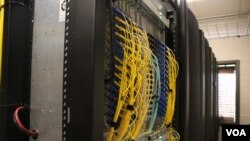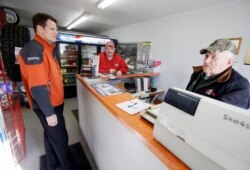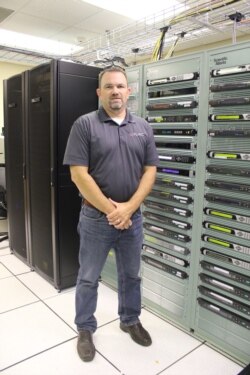A few years ago, the Oklahoma town of Tuttle suddenly found itself without cable or internet service after a local broadband provider went bankrupt, leaving behind unpaid bills to the power company.
“Tuttle, we believe, became the largest city in America without cable service or internet service,” said Tim Young, the town’s city manager.
Like the majority of cities in the U.S., Tuttle residents accessed broadband through private companies rather than through a city-run system. With the town of a few thousand growing quickly and attracting professionals from nearby Oklahoma City who were used to high-speed internet, Tuttle city officials began meeting with new private telecommunications companies to fill the gap.
According to Young, every one of them expressed the same concern: the population wasn’t big or dense enough to garner much of a profit.
Scouted other networks
So Young said he and other city officials changed strategies and began taking tours of other Oklahoma cities that had set up municipal broadband networks, meaning the system was owned and operated by the town.
“We began to realize that this is something that we could do ourselves and began to go down that path,” he said, noting that no taxes or rates were increased to pay for the upstart loan provided by a local bank. “From my standpoint, I’ve been more surprised by how easy and simple it is to put the system in.”
Across the United States, many Americans in small towns and rural areas are still struggling to access affordable, quality broadband. As more and more services move online, many people are missing out on entertainment, educational, health care and professional opportunities.
“One of the main reasons why the urban-rural disparity exists today in the private industry (is) because the big incumbent providers are naturally incentivized to build robust networks in high-density population areas, where they have a much greater chance of getting a return on their investment, versus building out a super robust network in a small town of 2,000,” said Tyler Cooper, editor at BroadbandNow, a data aggregation company based in Los Angeles.
In response to telecommunication providers’ complaints of high costs to serve more remote areas, the U.S. government has granted out hundreds of millions of dollars through bipartisan efforts to get fiber laid and more rural homes connected.
Frustrating results
The results have frustrated politicians and rural consumers alike. The digital gap remains, along with pervasive criticism that current FCC maps paint a misleading picture of how many Americans need assistance. These maps, created from self-reporting 477 forms provided by telecommunications providers, paint a picture where 21.3 million people, or 18 percent of the American population, lack access to broadband. In reality, observers of broadband access say that number is much higher.
“The Form 477 data allows providers to mark an entire census block as covered — potentially hundreds of homes — if even one of those homes is covered,” Cooper said.
Along with the federal government, state legislatures have attempted to tackle the digital divide, including passing legislation regulating municipal broadband. At the moment, more than two dozen states have limitations on city-run broadband — from restrictions on parameters to entire bans. While it is common in other countries for broadband to be provided through publicly owned utility services, U.S. conservatives have argued that government should play less of a role.
Arkansas, for example, passed a law in 2011 stating “a government entity may not provide, directly or indirectly, basic local exchange service.”
Earlier this year, the Arkansas Legislature unanimously voted to repeal that ban.
“We were one of the five states that had the most restrictive laws [on municipal broadband] in the nation, and [ranked] almost last in broadband [access],” Breanne Davis, a Republican state senator and co-sponsor of the bill, told Citylab earlier this year.
Cooper, of BroadbandNow, said that municipal broadband in rural communities in Arkansas, a state where a quarter of its residents are underserved, isn’t a guaranteed solution. In some cases, it has failed. He pointed to Wireless Philadelphia, which he says collapsed under the weight of massive overhead.
“A lot of state and city municipalities are not prepared to deal with the overhead that comes from actually maintaining and holding a fiber backbone. Turns out that’s a pretty big can of worms,” Cooper said. “It’s something that definitely has risks and is not just a utopian solution to the digital divide.”
At the same time, there are a large number of municipal-run broadband networks that appear to be succeeding. In the case of Tuttle, Young, the city manager, said excess revenue is being reinvested so that more rural homes can benefit.
‘Exceeded all expectations’
In Chattanooga, Tennessee, frequently touted as a shining example of quality municipal broadband, Mayor Andy Berke said the product “exceeded all expectations.”
“I don’t think the people had a true understanding of just how successful this would be,” Berke said, crediting the high-speed connection for Chattanooga’s low unemployment rate and bustling tech and innovation economy.
Even in Arkansas, a handful of towns that set up municipal broadband ahead of the ban say they have benefited from having it.
Paragould, a community of about 30,000, went into the cable business in the early 1990s, eventually including broadband and going into direct competition with a major private telecommunications company in town. Eventually, the city bought out the private company’s assets.
“The citizens weren’t happy with the offerings and the prices [of the other company],” said Marcus Dowdy, director of broadband services for Paragould Light Water and Cable.
Over the years, Dowdy said more and more Arkansas communities and co-ops have expressed interest in starting the process themselves.
“[Broadband] is going to become more of a utility,” Dowdy said.
Regardless of how successful future municipal broadband networks may be, Cooper said he can’t foresee a time when every house in America — no matter how remote — is eventually connected to a fiber network. In the end, there will be a combination of technology employed.
“It’s just too big of a project. There’s too much infrastructure involved,” Cooper said.









